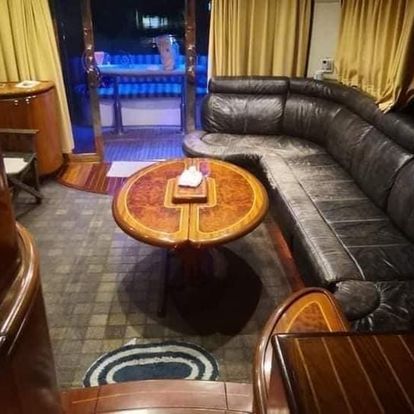Interior Cleaning Tips to Keep Your Yacht Fresh and Inviting
As a yacht maintenance expert with over 15 years in the industry, I’ve seen it all—yachts that have been impeccably cared for and those that could use a little more attention to keep them in top shape. One of the most common issues yacht owners face is maintaining a clean and inviting interior. Whether you're a seasoned yacht owner or new to the yachting world, keeping your yacht interior fresh requires regular upkeep, special attention to materials, and a bit of know-how.
In this guide, I'll walk you through practical interior cleaning tips to keep your yacht looking and smelling fresh, and explain how to avoid common pitfalls. From basic cleaning to dealing with specific yacht materials, I’ll share expert advice to ensure your yacht is always ready to impress—whether you're out on a sunny day or hosting guests for an evening cruise.

Yacht Interior Cleaning Tips
Cleaning the interior of your yacht is not just about making it look good—it’s about preserving the materials, preventing odors, and creating a comfortable atmosphere for everyone on board. The maritime environment can take a toll on your yacht, from saltwater corrosion to humidity, and it’s essential to protect your interior from these elements.
1. Establish a Regular Cleaning Routine
The first step to keeping your yacht fresh and inviting is to establish a consistent cleaning schedule. A yacht’s interior is exposed to dust, sand, and even salt residue from the sea breeze. Regular cleaning prevents dirt buildup, mildew, and the growth of mold, all of which can create unpleasant smells and cause long-term damage to your boat’s interior.
I’ve worked with yacht owners who only clean their interiors when they notice a problem—perhaps after a guest visit or before a big trip. But I always advise owners to set aside time for regular cleaning, ideally every 1-2 weeks. A little maintenance goes a long way in preserving the life of your yacht and creating a pleasant environment for everyone on board.
2. Vacuum and Dust the Interior
Vacuuming and dusting are crucial first steps in any yacht cleaning routine. With constant exposure to the elements, yachts often collect sand, dust, and debris, even in the most unexpected corners.
Key Areas to Focus On:
Upholstery: Sofas, cushions, and chairs can trap dust and dirt, which, over time, leads to staining and wear. Use a vacuum with an upholstery attachment to gently remove debris from fabric surfaces.
Flooring: Whether your yacht has wood, carpet, or vinyl flooring, dirt and dust can settle quickly. A quick vacuum will help prevent dirt from grinding into these surfaces. For hardwood floors, a microfiber mop works wonders at picking up finer particles.
Cabinets and Shelving: These areas tend to collect dust and can be easily overlooked. Make sure to wipe down shelves, cabinets, and counter spaces with a microfiber cloth.
I recall a client of mine who had a beautiful yacht with plush seating in the salon, but she often complained about a musty smell. After some inspection, I found that the issue stemmed from the upholstery, which was holding onto dirt and moisture. A deep vacuuming session helped immensely in lifting the debris, and regular cleaning thereafter kept the scent fresh.
How to Clean Your Yacht Interior
When cleaning your yacht’s interior, it’s important to use the right products and techniques, as yacht materials differ significantly from what you’d typically find in a home. The humidity on a boat, combined with the salt from the sea air, requires specific care.
1. Use Non-Abrasive Cleaners
Harsh chemicals or abrasive cleaners can damage the delicate surfaces of your yacht, from the wood panels to the polished metal fixtures. Stick to cleaners specifically designed for marine environments or opt for gentle, eco-friendly options.
For instance, I’ve found that a simple mixture of mild dish soap and water is often sufficient for most surface cleaning tasks. For stubborn stains, a marine-grade cleaner can work wonders without harming the material. Be sure to test any product on a small area first to avoid discoloration.
Pro Tip: When cleaning your yacht’s wood surfaces (whether it’s teak, mahogany, or oak), avoid using cleaners with ammonia, bleach, or vinegar, as these can strip the finish and cause long-term damage.
2. Tackle Stains Quickly
Spills and stains are inevitable on a yacht, especially when dining or entertaining guests. However, the quicker you address them, the easier they are to remove. For food and beverage stains on upholstery, always blot (don’t rub) the area with a clean cloth. For fabric or upholstery, I recommend using a fabric cleaner designed for marine environments. Make sure to follow the instructions carefully to avoid damaging the fabric.
For carpet stains, especially in high-traffic areas like the salon, a specialized carpet cleaner for boats is your best bet. I once worked on a client’s yacht where the carpet was constantly stained by the foot traffic from the galley to the salon. After a deep clean with the right products, the carpet looked as good as new.
3. Sanitize and Disinfect Surfaces
Keeping your yacht’s interior smelling fresh is about more than just cleaning. Moisture and humidity are a constant concern on the water, and they can lead to mold and mildew growth if left unchecked. Pay particular attention to high-humidity areas such as the galley, head (bathroom), and lower cabins.
To prevent mold and mildew, use a disinfectant that is safe for marine environments, especially in the kitchen and bathroom. A simple solution of water and white vinegar can help disinfect surfaces, but make sure to thoroughly wipe away any residue afterward. You’ll want to avoid leaving a lingering vinegar smell, especially in the enclosed spaces of a yacht.
Tip for Freshness: Keep the air circulating by using dehumidifiers or air purifiers designed for marine use. These devices not only reduce humidity but can also keep your yacht smelling fresh.
4. Cleaning the Galley and Head
The galley (kitchen) and head (bathroom) often require more attention than other areas, as these spaces tend to accumulate grease, soap scum, and grime.
For the galley:
- Clean countertops, sinks, and stoves regularly to remove food residue and prevent grease buildup.
- Use a marine-grade cleaner to tackle stainless steel surfaces. A mixture of baking soda and water works wonders for cleaning your stove without scratching the surface.
- Pay attention to the fridge and storage areas. Clean out old food and wipe down the shelves with a mild soap solution to prevent odors.
For the head:
- Use a disinfectant specifically designed for bathrooms on boats to clean the toilet and surrounding areas.
- Regularly check for any leaks or water damage, as moisture can lead to mold or mildew in confined spaces.
- Don’t forget to clean the shower area. Marine-grade soap scum removers are formulated to tackle the unique challenges of a yacht bathroom.
5. Freshen Up Fabrics and Cushions
In addition to regular vacuuming and wiping down surfaces, the fabrics and cushions inside your yacht need to be cleaned to remove built-up odors and dust. Consider using a fabric freshener or a non-toxic cleaner for upholstery to keep things smelling fresh. In between deep cleanings, you can use a fabric steamer to help eliminate odors from cushions and mattresses.
Personal Tip: I’ve found that taking removable cushions and fabrics off the yacht to clean them thoroughly (every season) helps maintain a fresh environment and avoids any long-term buildup of dirt or moisture.
Yacht Maintenance Cleaning: Beyond the Basics
While interior cleaning is crucial, don’t forget to maintain the overall health of your yacht to keep things running smoothly. Keeping your boat’s engines, electronics, and exterior in top shape ensures a more enjoyable and safe experience on the water. Regular checks of the hull and exterior can also prevent issues that might lead to excess moisture entering the interior spaces, thus preserving the cleanliness of your yacht.
Tip for Maintenance: Schedule professional yacht maintenance at least once a year to check for any wear or potential problems with the plumbing, wiring, or engines. A well-maintained yacht is easier to clean and keeps your interior looking and smelling pristine.
How to Keep Your Yacht Fresh
Finally, the key to keeping your yacht inviting is maintaining an environment that is fresh, clean, and free from odors. Regular cleaning, proper ventilation, and using odor-absorbing products (like activated charcoal or dehumidifiers) will help you achieve this.
If you’re planning a longer trip or are preparing to welcome guests aboard, a quick once-over with air fresheners designed for boats can provide that extra burst of freshness that will make your yacht feel like home on the water.
Conclusion
Maintaining a clean and fresh yacht interior takes consistent effort, but the rewards are well worth it. By establishing a regular cleaning routine, using the right products, and staying on top of specific maintenance tasks, you’ll ensure that your yacht remains inviting, comfortable, and a joy to spend time in. Whether you’re on a weekend getaway or hosting a dinner party, a pristine interior is one of the easiest ways to elevate your yacht experience.
Get Started with Blue Moon Yacht Services
When it comes to yacht detailing, Blue Moon Yacht Services provides all the care your vessel needs to look and perform at its best. Contact us today to discuss a customized detailing package that includes teak restoration, gelcoat repair, metal polishing, and more.

Contact us
📞 (760) 798-9292
(858) 945-8610
📍 Address: 2907 Shelter Island Dr, San Diego, CA 92106
